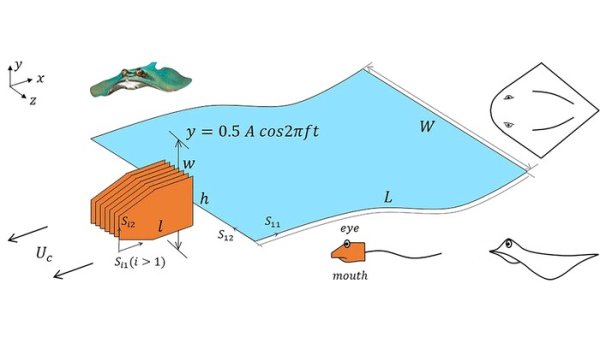
The eyes and protruding mouth of stingrays, like the one pictured at the World Aquarium in St. Louis, help them swim with greater thrust and accelerated cruising, according to a new study. File Photo by Bill Greenblatt/UPI | License Photo
Aug. 31 (UPI) -- Stingrays are able to glide so effortlessly through the water thanks in part to their protruding eyes and mouth.
Sea rays, including stingrays and skates, are noted for their streamlined body and flexible pectoral fins. These features offer obvious hydrodynamic benefits, but some scientists assumed their protruding eyes and mouth were hindrances.
In a new study, scientists modeled the effects of these protuberances on a variety of forces, such as pressure and vorticity, that influence propulsion.
Their analysis -- published Tuesday in the journal Physics of Fluids -- showed a stingray's protruding eyes and mouth actually help it move through the ocean water more efficiently.
Researchers began by building a model of the stingray's self-propelled flexible plate. They clamped the front end of the plate and programmed it to perform rhythmic, up-and-down oscillations -- the same movement pattern stingrays use to swim.
Next, the researchers added rigid plates to the model to mimic the effects of the stingray's eyes and mouth, comparing the hydrodynamic efficiency of models with and without the added plates.
"Managing random fish swimming and isolating the desired purpose of measurement from numerous factors are difficult," study corresponding author Hyung Jin Sung said in a press release.
"To overcome these limitations, the penalty immersed boundary method was adopted to find the hydrodynamic benefits of the protruding eyes and mouth," said Sung, a researcher at the Korea Advanced Institute of Science and Technology.
Data showed both the stingray's eyes and mouth yielded a front-back vortex of flow that increased the negative pressure in front of its body, easing its path through the water.

The eyes and mouth of a stingray help it swim more efficiently, researchers found in a modeling study. Illustration by Qi-an Mao
A side-to-side vortex created by the protuberances also boosted negative pressure above and below the stingray, the researchers said.
According to the model, these pressure shifts provided the stingray with greater thrust and accelerated cruising.
In total, scientists determined the stingray's protruding eyes and mouth boost propulsion efficiency between 10% and 20%.
The insights provided by the modeling effort could be used to design more hydrodynamic autonomous underwater vehicles, according to the researchers.
No comments:
Post a Comment